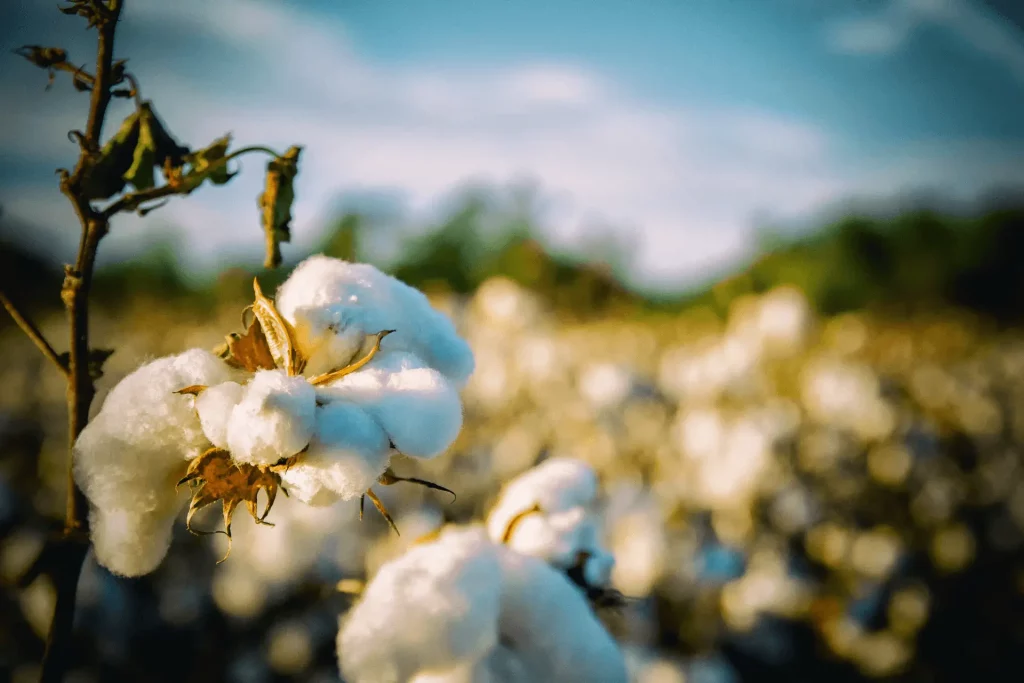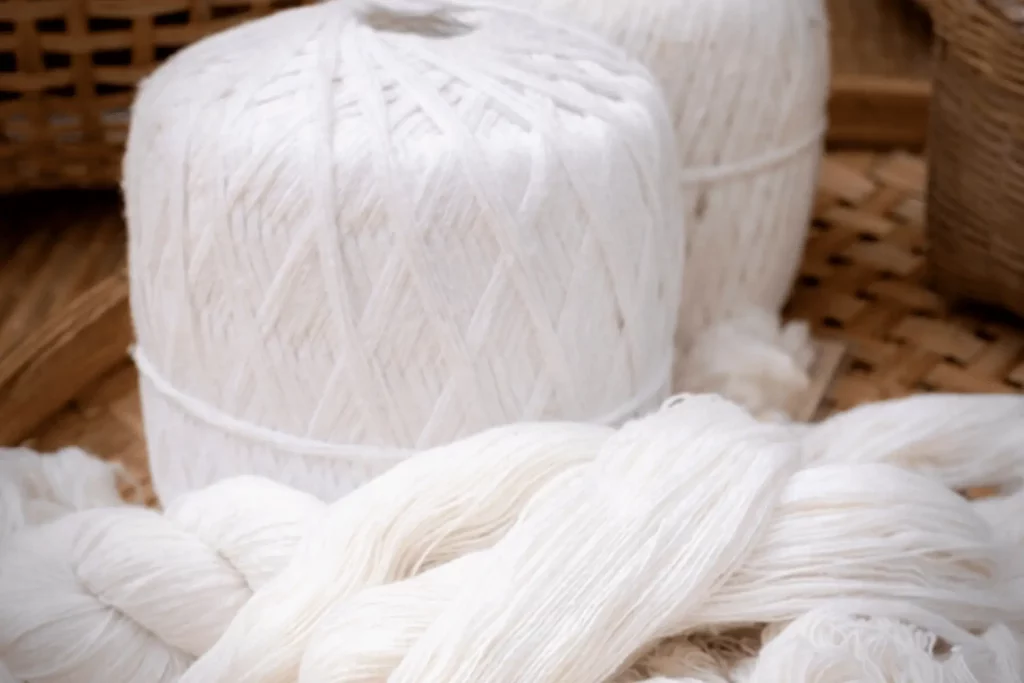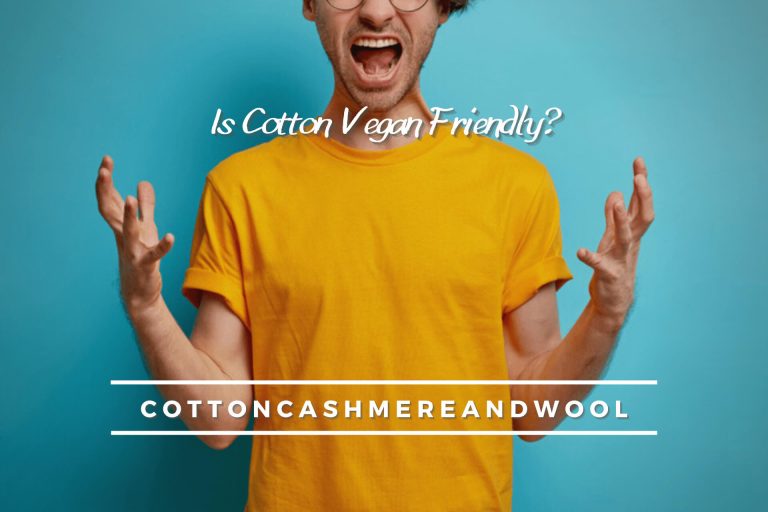Are you vegan and wondering is cotton vegan-friendly option for clothing, bedding, and other fabrics? We know that getting dressed every day can be overwhelming enough as it is — not to mention navigating the complex animal product/vegan fabric labels out there! That’s why we’re here today with all the details about whether cotton is considered vegan.
Find out more in this blog post, where we tackle everything from sustainable farming practices to what makes a material “vegan.” Please keep reading for all the information on one of our go-to wardrobe staples: cotton!
Table of Contents
What is Cotton?

Cotton is a type of natural fiber gleaned from cotton plants, which are often mass-cultivated for their fiber-producing potential. Cotton produces a durable fabric capable of effectively wicking away moisture, is straightforward and inexpensive to manufacture, and so on.
It has been used in the production of clothes for thousands of years, and it is no surprise that it is still one of the most widely used textiles today.
How is Cotton Made?

Cotton fibers are harvested from the outer layer of the seed casing that the cotton plant forms as it grows. After the cotton fiber has been gathered, removed from the cotton seed, washed to remove any impurities, and then either “carded” or “combed,” two processes that are very comparable and are used to prepare the cotton thread for a spin by the line up the individual fibers, it is ready to be utilized.
Because of its lower cost, carded cotton is the material for most applications. The cotton is then transformed into yarn after the carding or combing process. After being colored, this yarn is woven into the garments, upholstery, and other things that we may find in the racks of our neighborhood stores.
Is Cotton an Eco-Friendly Material?
When cultivated sustainably, organic fiber, which is also organic and biodegradable, is seen as having a lower impact on the environment. Unfortunately, the production of cotton on a vast scale has led to the employment of several techniques that could not be more able.
Cotton is frequently produced in locations that could be less since it is necessary to have the highest feasible volume while keeping expenses as low as possible. As a result, enormous amounts of water, fertilizer, and pesticides are required to obtain the most significant potential yield.
Because the usage of pesticides, of course, may cause some harm to certain animals, and because this can cause significant damage to the surrounding ecosystem, vegans may view this as an issue.
Cotton can be farmed sustainably; however, doing so will result in a price increase for the finished product. On the label of your garment, the term “organic cotton” will often be used to refer to cotton that was farmed sustainably.
This indicates that it was grown in regions that receive adequate rainfall (so the cotton does not require excessive watering). It also shows that no pesticides were employed in its cultivation. This method is far more sustainable but produces a lesser yield, which means it costs more.
Types of Cotton:
One may argue that cotton can only be considered vegan if it is cultivated without using chemical fertilizers, pesticides, or fertilizer from animals.
1. Veganic Cotton:

The Vegan Organic Network defines “veganic” as a method of cultivating food and other plants that do not involve the use of chemical fertilizers or pesticides, genetically modified goods, or items originating from animals.
Instead, “veganic” emphasizes the use of exclusively plant-based fertilizers. Finding vegan cotton might be more challenging said than done, given the current state of affairs, but there is still reason to have faith that vegan items will become more commonly available.
2. Genetically Modified Cotton:

Many individuals have an irrational dread of anything genetically modified (GM), probably due to the numerous stories of the “Frankenstein food” variety published in the media when the technology first became extensively employed.
Conversely, cotton is typically worn rather than consumed; so far, fewer people may be concerned about applying genetic modification to cotton.
This is because the majority of the worries regarding genetic modification center on the potential effects that it could have on humans who consume crops that have been genetically modified.
Genetically modified cotton has improved the environment and animals by lowering the demand for chemical pesticides.
Through genetic modification (GM), cotton seeds have been produced that include a bacterium called Bacillus thuringiensis. This bacteria is very poisonous to some pests that feed on cotton plants or cause harm to them.
This strategy is far more successful than using broad-spectrum chemical pesticides, which have the potential to kill or hurt a wide variety of insects (including bees) and other animals that wouldn’t certainly have caused any damage to the crop had it not been for their presence.
Research has shown that using genetically modified cotton is less environmentally harmful than chemical pesticides. However, there are still many concerns that need to be answered about genetically modified crops in general.
However, another study reveals that secondary pests might emerge, requiring continued administration of pesticides; therefore, the issue is not as black and white as it may seem at first glance.
3. Cotton Moon:

In addition to being a very adaptable plant that plays an immensely significant role in the history of humanity, the cotton plant has also shown to be something of a pioneer in its own right. After the Chinese Change 4 lunar mission landed on the opposite side of the moon in January 2019, cotton seeds stored in a biosphere inside the probe began to germinate.
It was the first time humans had grown anything on the moon, even in a controlled environment, and the sprouts that emerged marked the occasion. Even though the plants did not survive for very long, and the experiment was said to be over after only a few days, it was still considered a victory for the lowly cotton plant.
If you are curious about the various types of fabric associated with cotton, please visit this blog for more comprehensive information.
Are there any Ethical Issues with Cotton?
Cotton production can have various ethical issues, from using insecticides and pesticides to exploiting labor. In many countries, farmers are often required to purchase expensive cotton seeds or hire costly workers who need access to credit. This creates a cycle of poverty that can lead to child labor and other unethical practices.
Additionally, many insecticides used in cotton production are toxic and have been linked to health problems, including respiratory illnesses, congenital disabilities, and cancer. Cotton is also a significant contributor to water pollution due to runoff from chemical fertilizers, herbicides, and pesticides.
Another ethical issue with cotton lies in its production process. Using synthetic fertilizers can lead to soil erosion, leading to loss of productivity for farmers over the short-term and long-term damage to land and ecosystems.
Additionally, much of the cotton produced worldwide is genetically modified (GMO), which can create new problems regarding pest management and crop yields. Finally, some countries where cotton is made may not have labor laws that protect workers’ rights, leading to exploitation and unsafe working conditions.
Given these issues, consumers need to be aware of the ethical implications of cotton production. Many companies have addressed some of these concerns by using organic or fair-trade cotton, ensuring that workers are paid a fair wage and work in safe conditions.
Ultimately, however, it is up to consumers to research the brands they buy from and ensure they are aligned with their values regarding ethical practices. By doing so, we can all do our part in supporting sustainable production that respects people and the planet alike.
Frequently Asked Questions:
How many cotton plants are used to make a shirt?
In the end, you’ll need about four cotton plants to harvest that much cotton; however, individual plant yields vary widely, so this is only an estimate.
Is cotton native to America?
No, cotton is not native to America. It originated in the tropical regions of the north and south India, where it has been cultivated for over 5,000 years. Cotton spread from India to Egypt around 1000 BCE and throughout Europe by 600 CE. The English began planting cotton in the Jamestown settlement in 1607, but it wasn’t until Eli Whitney invented the cotton gin in 1793 that American farmers began cultivating large amounts of cotton. Today, most of the world’s cotton is grown in countries like China, India, Pakistan, and the USA. But its roots are firmly planted in India – proof that you don’t have to go far for innovation!
Bottom Line:
Cotton may not be vegan, but if you choose cotton-based items, look into companies and the materials that they use. Purchasing products with sustainable materials and minimal resources can help lessen our clothing choices’ environmental impact. Remember also to check labels and labels of other vegan-friendly fabrics like linen, bamboo, and hemp. Ultimately, as long as we purchase quality items with little or no animal-sourced materials, clothes can still be stylish and cruelty-free. So go ahead, snuggle up in your favorite cotton shirt, and know that you are making a responsible choice for both people and the planet.

